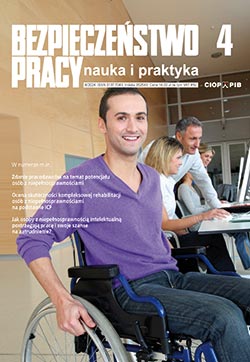Young mothers in the labour market
Karolina Pawłowska-Cyprysiak
Maternity and occupational activity are two main factors that affect load women experience. They devote three times more time to everyday care of children than men do; insufficient availability of formal care of children also influences women's participation in the labour market. Women with disabilities are special in this respect. They are seen as less independent, which also limits their access to many services (e.g., related to the labour market and social services). Those women are also seen as not able to have children and be a mother. This results in issues related to being a mother and a worker being neglected. This article analyses literature on the problems of young mothers, with and without disabilities, with particular emphasis on the impact of parenthood on their economic activity.
Relationship between psychosocial risk factors and sick absenteeism at work
Małgorzata Pęciłło-Pacek
In general, the results of research on the influence of psychosocial risk factors on sick absenteeism are related only to the relationship between the two variables and it is not possible to indicate a predictor in this relationship. The statistical analyses presented in this article show that in some cases absenteeism can be a predictor of psychosocial factors at work.
Simultaneous use of industrial safety helmets and other personal protective equipment
Krzysztof Baszczyński,
Many workstations in construction, mining, energy, forestry, storage pose a serious risk for workers due to the presence of more than one hazardous factor. The situation is special if there are mechanical factors hazardous for the worker’s head, which necessitate the simultaneous use of safety helmets together with other personal protective equipment. This paper presents problems associated with using helmets together with clothing protecting against thermal factors, eye and face protective equipment, respiratory protective equipment and hearing protective equipment. The results of laboratory tests addressing the dangerous phenomena accompanying combined application of such equipment are presented. The tests included, among others, filming with a high-speed camera the effects of impact on the helmet placed on a headform with, e.g., protective glasses. The paper provides preliminary guidelines enabling appropriate selection and joint application of helmets and other personal protective devices.
Selected aspects of the employer’s responsibility in cases of mobbing
Helena Szewczyk
The employer’s responsibility in cases of mobbing in view of Poland's Labour Code comes down to above all compensation liability for termination of employment by the victim of mobbing and payment of indemnity for the employee's health problems. As a result of mobbing, the victim of mobbing may also suffer from para-occupational diseases. In some cases, the effects of mobbing, like the effects of extreme stress (excessive physical effort) caused by mental abuse in the work environment, may become an external cause for an occupational accident. However, protection against mobbing in an employment relationship goes significantly beyond the scope of labour law and social insurance law norms. It should be assumed that the norms of civil law significantly contribute to creating means of protection against mobbing. Regardless of the effects provided for by labour law and civil law regulations, mobbing may also result in consequences under criminal law for the perpetrator and the employer.




























